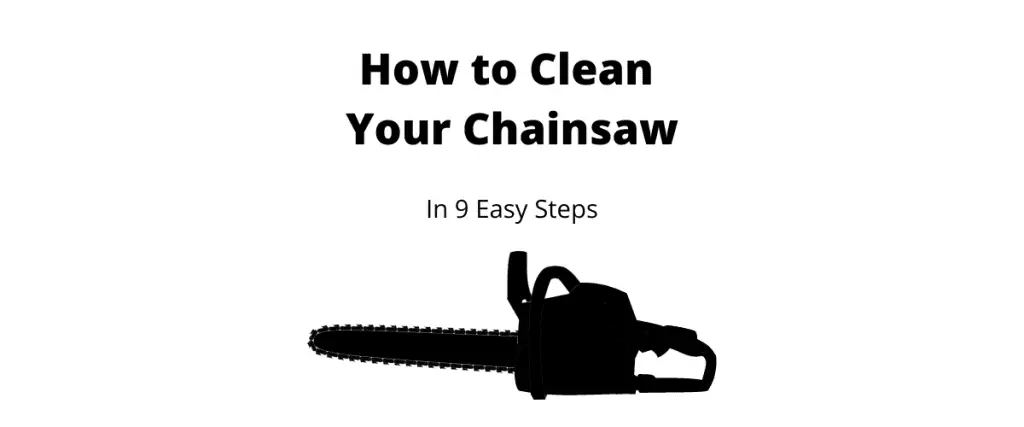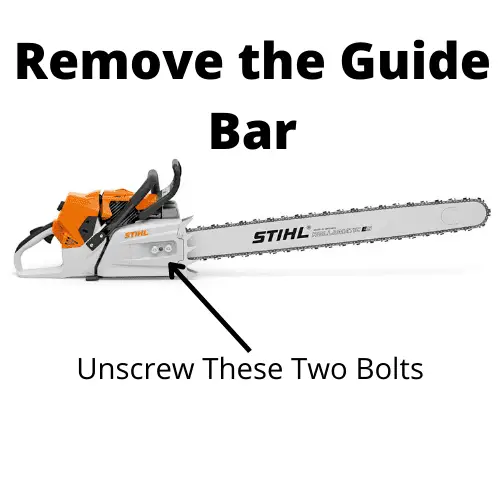To clean a chainsaw, remove the chain and guide bar, clean debris with a brush or compressed air, and wipe down the exterior. Clean the air filter, spark plug, and cooling fins with a soft brush. Remove and clean the sprocket cover and clutch drum. Reassemble the chainsaw and check for proper operation.
Keeping your chainsaw clean is essential to getting the most value for money out of your tools by increasing their life. Chainsaws often get covered in sawdust, sap, oil, and gas. This can make a messy situation out of your gear and can cause corrosion. Chainsaws run at extremely high rotational speeds, so keeping them clean reduces the friction and ensures top performance.
I have spent over a decade working in the forestry industry and firmly believe that keeping your machine in good condition can save hours of headaches down the track. So let’s dive into the actual steps to clean a chainsaw.
Table of Contents
Why Do You Need to Clean Your Chainsaw
Chainsaws work in dirty environments, and the internal components can quickly be covered in:
- Sawdust
- Sap
- Oil
- Grease
- Dirt
- Metal Filings
The combination of oil and sawdust forms an extremely sticky substance (that I call ‘gunk’) that can significantly increase the friction through the chain, reducing its speed and effectiveness. The environment is also extremely dusty, which blocks the air filter. This can limit the airflow into the engine, reducing the combustion efficiency. In a gas-powered chainsaw, the carburetor and the spark plugs can block – keeping all these components clean solves 90% of the issues you will encounter.
Tools Required
There are plenty of different tools you can use to clean your chainsaw, but these are my ‘must have’ options:
- Ammonia (at least 1 cup)
- Bucket of Water
- Gloves and Safety Goggles
- Damp Cloth
- Stiff Brush
- Wrench
Compressed air is also useful for getting material out of hard-to-reach locations. You can find dedicated bar groove cleaning tools, but I have found that a knife or screwdriver works just as well.

How to Clean a Chainsaw
I have a 9 step process for cleaning my chainsaw. Most of these steps are dedicated for gas-powered chainsaws, so if you have an electric chainsaw you can stick the steps that don’t apply.
-
Preparation
Regardless of the type of chainsaw, ensure it is cool before cleaning. Unplug the cord or remove the battery from an electric-powered chainsaw, and apply the chain brake.
Remove any excess dust from the external components of the chainsaw with a damp cloth. It is important to remove this before you start opening up the machine and risk it falling deeper into the mechanism.
-
Remove the Chain and Bar

Next is to take the chain and guide bar off. This is done by unscrewing the bolts connecting the bar to the powerhead. You can also remove the chain from the bar by removing the sprocket.
-
Clean the Guide Bar
Use soapy water to remove any excess dirt from the guide bar. If it is covered in oil, use a solvent degreaser to help bring it back to a clean condition.
Check if there are any blockages in the guide bar groove. You can use a knife or screwdriver to clear this channel until it is free of material.
-
Clean the Chain
The next step is to clean the chain in an ammonia solution, so make sure you put on some gloves and safety goggles for safety. I have also seen people clean their chains with turpentine.
Take the chain off the guide bar and place it in a bucket mixture of 1 cup of ammonia to 1 gallon of water for 10-20 minutes. Use a stiff brush to remove any material left on the chain. Rinse it with fresh water and leave it to air dry while you move on to the next steps (also another good use of an air compressor to speed up the drying time).
This is also a good time to sharpen your chain and remove any metallic burrs that have formed.
-
Clean the Air Filter
The air filter will quickly block or be restricted due to the sheer amount of dust in the air. This needs to be cleaned frequently. Most of the time, it can be cleaned with compressed air – but be careful that you don’t damage it by using too much pressure.
If it gets filthy, then you should soak it in soapy water. You can just replace the entire filter if it gets too bad.
-
Clean the Spark Plug
If your spark plug is relatively new, it should be in good condition, but you will notice degradation as it ages. Check the gap between the electrodes – it should be around 0.02 inches. Clean any dirt off the electrodes with a stiff brush. If the electrodes have gone a deep black, then it might be worth replacing it, especially if you have started to notice problems with the engine firing.
-
Check the Carburetor
The carburetor can get gunk building up. Check if there is any material – most of the time, it will be fine. If there is any residual material, then the easiest method is to blow it out with compressed air. This can block the flow of gas into the engine.
-
Clean the Cooling Fins
The cooling fins on the powerhead are crucial to keep the motor as cool as possible and do lose efficiency as they are covered in dust. These can be cleaned with a damp cloth or compressed air.
-
Reassemble the Chainsaw
Now is the time to put everything back together the same way it was removed.
Before you reattach the chain back onto the guide bar, dip it in your choice of bar oil. Let any excess oil drip off. Put the chain back into the grove of the guide bar and attach the sprocket. Reattach the guide bar to the powerhead and tighten the bolts securely. Tension up the chain.
I always run my chainsaw for 1-2 minutes before the next use to give the bar oil pump enough time to coat the chain completely and warm up the engine.
If you want to visualize these steps, then have a view of this video:
How Often Should You Clean Your Chainsaw
You should clean your chainsaw with a damp cloth every time you refill the gas tank or replace the battery. This will remove the bulk of sawdust from the external components before they can work their way into more hazardous internal mechanical locations.
I also give my chainsaw a deep clean whenever I need to remove the chain, such as to sharpen it. This guarantees that the chainsaw will perform at the highest level, reducing time and muscle fatigue for each cut.
You should also do a more thorough clean before you put your chainsaw into storage.
Conclusion
The best way to keep your chainsaw running for years to come is to maintain it properly, and cleaning is a key step. I recommend giving your tool a wipe of excess dust with a damp cloth every time you refuel it and then do a deep clean whenever you sharpen the chain. This may seem like overkill, but it keeps your tool in top condition, and you will notice the lack of degradation as the internal mechanics stop blocking with dust and sap.
If you have questions related to your particular model (like you can’t figure out how to remove the air filter), then your best bet is to read through the operating manual.
